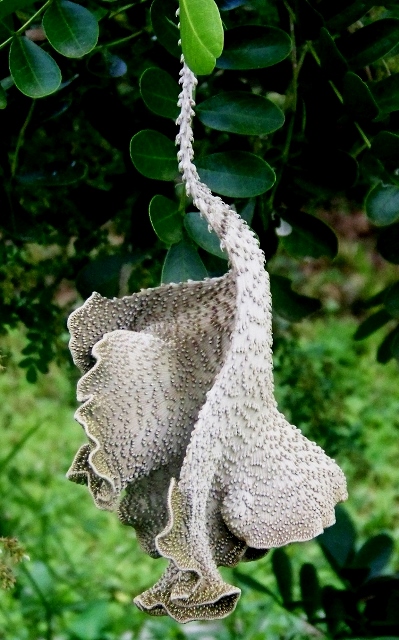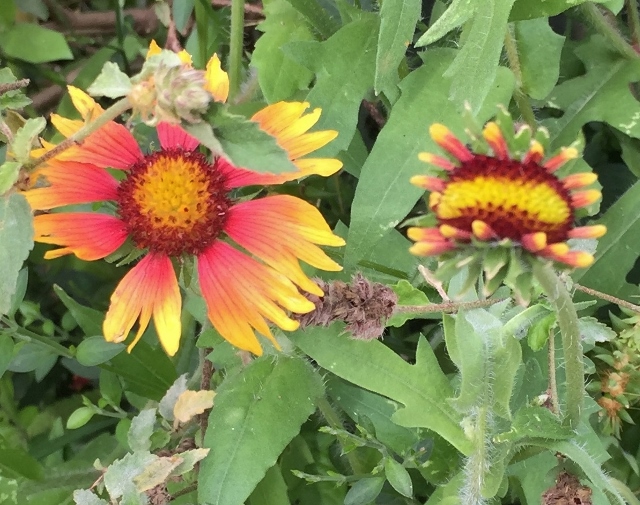

Fascination with Fasciation
by Anita Westervelt, Texas Master Naturalist
Fasciated is a weird word for a weird botanical condition. Pronounced făsh′ē-ā′tĭd, it is a rare, abnormal growth in vascular plants — plants that possess xylem (water-conducting tissue) and phloem (food-conducting tissue).
In normal plant growth, the growing tip (commonly the flowering part) is normally concentrated around a single point and produces approximately cylindrical tissue. In fasciated growth, the growing tip becomes elongated perpendicularly and produces a flattened, ribbon-like, crested, or elaborately contorted tissue.
Simply, it’s an anomaly in the plant world.
Texas mountain laurel, Sohpora secundiflora, is susceptible to fasciated growth. In the fabaceae (pea) family, normally, Texas mountain Laurel flowers would be big clusters of fragrant, purple, pea-flower-like blooms; seed pods would look like short, plump, sugar snap pea pods you’d find in a grocery store. The fasciated growth resembles miniature twisted moose antlers.
Fasciation has several possible causes including hormonal, genetic, bacterial, fungal, viral and environmental. The condition is common in cacti and succulents. Willows, cockscombs and foxgloves also frequently show this abnormality.
A fasciated phenomenon doesn’t just occur in flower heads. Roots, stems and fruit can be fasciated.
Plants rely on a growing point, called the apicalmeristem, (dividing tissues at the growing tips of shoots and roots) to produce new parts and pieces.
Meristematic cells eventually transform themselves into leaves, stems and flowers. These meristem cells are biologically pliable, somewhat like human stem cells; occasionally things go amiss in plants and fasciated growth happens.
Searching the Internet for fasciated plant images brings up several iconic views of fasciated, or crested, growth in Arizona’s famed saguaro cactus.
Interestingly, one of my all-time favorite plants, cockscomb (Celosia), seemingly is prone to fasciation.
When I lived in the Midwest, I acquired seeds from a stand of cockscomb that had re-seeded itself in an active cow pasture for more than fifty years, most likely a former garden where an old farm house once stood. I successfully grew more than twenty plants from those seeds. Most had beautiful, velvety, deep red flower heads the size of a dinner plate. The plants grew to four and five feet in height, with thick, corrugated, lime-green stalks. These cockscomb were so gorgeous, I would gaze into their depths and absolutely marvel at their stunning design.
In the fall, monarch butterflies covered the flower heads. It was thrilling.
Now, researching fasciated plant growth, I discovered that cockscombs really should look like the photo on the seed packets found in revolving stands in the garden area at retail stores. Apparently, the huge, swirly ones I grew are considered fasciated.
While fasciation in flowers is usually a one-time occurrence, sometimes the fasciation is carried in the plant’s genetic material so that it reoccurs from generation to generation which apparently was the case with the cow pasture cockscombs.
More often, fasciated plants have to be propagated to carry on the unusual characteristics. Some horticulturalists intentionally try to reproduce fasciated plants by using grafting or cutting propagation methods. Purposefully fasciated cactus and succulents are an excellent example of this phenomena popular in the retail plant trade.
The Rio Grande Valley Chapter, Texas Master Naturalist develops knowledgeable volunteers dedicated to the study and conservation of natural resources and natural areas in the Lower Rio Grande Valley and helps the natural world through service, outreach and education.
